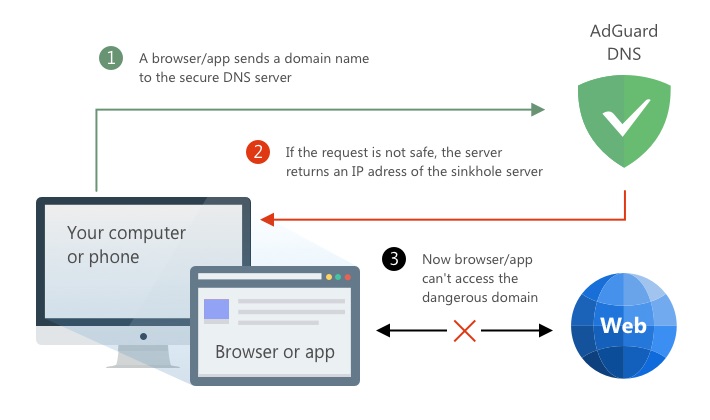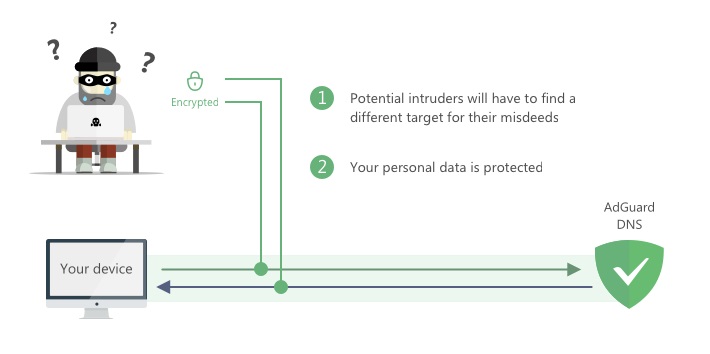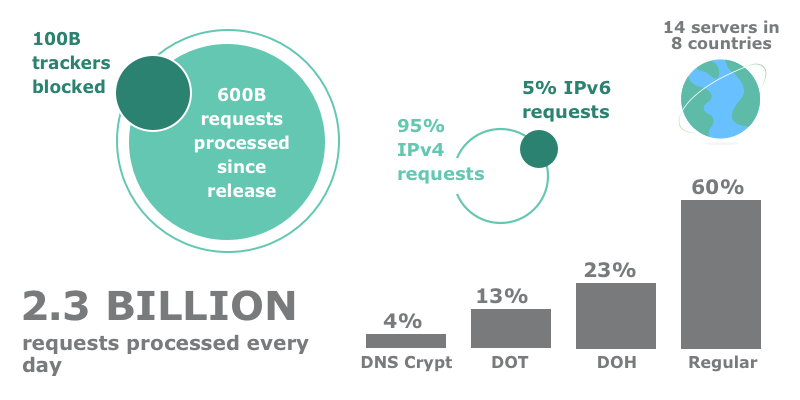AdGuard DNS: 1 year, 600B requests, 100B blocked trackers
There's no shortage of special occasions in December, but we want you to share with us yet another one. This is a special moment for us: it's been exactly one year since the official release of AdGuard DNS — an alternative way to block ads and tracking.
One year may seem like not so large of a timespan, but it certainly feels like it to us. Perhaps it's because AdGuard DNS has quite a history prior to the release. Or maybe it's because we've come such a long way during that last year? In any case, let's take a minute to look back at how it all started, inspect what has changed since then, and also try to peek into the future of AdGuard DNS.
A long time ago...
...an article appeared in our Blog with a simple title "Adguard DNS (beta)". Yes, it was 'Adguard' back then. It feels wrong by now to type that lower case 'g', but I digress. It hapened in July 2016, and it was the very first public mention of AdGuard DNS, so why do we only now celebrate the first anniversary?
DNS-based ad blocking works very differently compared to traditional ad blockers. Instead of filtering web traffic, AdGuard server recognizes DNS requests to ad and tracking servers and instead of a correct IP address returns nothing.

AdGuard DNS blocks requests to ad and tracking domains
Similar approach had been used before, of course. The idea of an ad blocking server is not new but there are not too many of those even today. It was certainly a completely unexplored avenue for us, so no wonder we felt a bit nervous about releasing AdGuard DNS. So we called it "beta" for the time being. It allowed us to monitor the performance, add new features and overall better the product without needless pressure and tight deadlines. Having said that, even then AdGuard DNS had much of what defines its identity today: the choice between Default and Family options, blocking of trackers and phishing websites. Those are core traits of AdGuard DNS, but it would be more than two years of improving and building upon them before this 'beta' tag could go away.
The road to release
AdGuard DNS passed several important milestones on its way to the first official release version. With each of them, it was becoming an increasingly more solid product.
DNS privacy
One of the most important ones was the addition of DNSCrypt support. DNSCrypt is an encrypted protocol which can be used for interaction between client and server instead of the regular, unsafe one.

DNSCrypt protects your DNS traffic
Nowadays, DNSCrypt is becoming less popular. It even had a near-death experience (but survived, thankfully). But it was a crucial step for AdGuard DNS for a different reason: with the addition of DNSCrypt support, we made clear that privacy is one of our top priorities regarding AdGuard DNS, much like with all other AdGuard products.
Today, DNSCrypt is still being used, but more modern and secure DNS encryption protocols emerged since then and stole the spotlight from it. I mean, of course, DNS-over-HTTPS and DNS-over-TLS (or simply DoH and DOT).
We're especially pleased to see more and more people adopting these new privacy-friendly protocols: they exploded in popularity in the last year, showing absolutely crazy increase in numbers. We'll touch on it more later.
Our servers
When we talk about a DNS resolver, its impossible to avoid the topic of speed. Even the most privacy-oriented DNS resolver would quickly lose interest from users if it works slowly. The speed of a DNS resolver depends on many things, but one of the most basic aspects is the number of servers. It's really simple: the more servers you have around the world, the better are the chances that a random Internet user will find one nearby. AdGuard DNS beta only had one server. Over time, our confidence in the product grew (thanks to you!), and we added more and more servers. By the time of the official release, we had 12. By today this number has reached 14 and we don't plan to stop.
Integration with AdGuard apps
While on desktop you can just go to system settings and configure them to set up any DNS resolver you want, for Android and iOS users it's not as trivial, especially for mobile networks. Usually you'd need to use some app for this purpose. So it came natural to us to add such option to AdGuard apps for Android and iOS. This proved to be a great success: users actively take advantage of DNS filtering in AdGUard apps and this contributes a significant portion of the total AdGuard DNS traffic.
AdGuard DNS today
It's always satisfying looking at numbers at the end of the year when you did a good job, and we couldn't resist too. Over the last year AdGuard DNS processed 600 billion requests. That's insane. And next year this number will only become higher. Today we already see that 2.3 billion requests gets processed each day.

AdGuard DNS today
When you read AdGuard blog, you're gonna see us talk about privacy a lot. So let's check how did the privacy-related numbers change:
-
the number of processed DoT requests per second (RPS) increased 14 times compared to the last year;
-
the same number for DoH requests is even more crazy: 46 times more requests per second;
-
it's even more impressive when compared to the total increase in RPS: 3 times more than at release, from 9 000 to 27 000 RPS.

AdGuard DNS: 2018 vs 2019
I'll say it again, we're just happy to see people taking their online privacy seriously. These numbers show just how far we've come in this last year, and all of this was possible only thanks to all of you who were using and supporting AdGuard DNS.
Here's to another year!
What'll happen next? The short answer is: we'll continue working on AdGuard DNS like we did all this time. But what exactly can you expect to see?
- More servers.
The more people use AdGuard DNS — and this seems to be the trend — the more servers we'll continue to add. We're also constantly monitoring the performance of our servers and don't shy away from moving to a different hosting if needed, or make other necessary changes to keep the speed high and servers reliable.
- Integration with desktop apps
On Windows and Mac it's much easier to set up a custom DNS, but it's still a lot of clicks. We plan to include DNS filtering as a new option in AdGuard for Windows and AdGuard for Mac, and AdGuard DNS certainly will be one of the default options there.
- Overall improvements
We don't know yet where exactly the next year will take us, but we know for sure that AdGuard DNS will become better and better. We have lots of ideas, and it's easy to track our progress on this Github page. You too can suggest us a new feature, report a bug or help in some other way.
Conclusion
I didn't have an opportunity to mention this before, but we at AdGuard consider this highly important: AdGuard DNS is open source, just like any other free AdGuard product. We believe this is how all freeware should be, and we plan to keep AdGuard DNS that way. The same GitHub repository is the place to go to view the source code.
You can't really make an article about AdGuard DNS and not tell people how to use it. For the detailed setup guide for each OS visit this page. But if you're just looking for addresses to enter, here they are:
Our DNS servers:
94.140.14.14or94.140.15.15for "Default";
94.140.14.15or94.140.15.16for "Family protection".DNS-over-TLS:
Use
dns.adguard.comstring for "Default" ordns-family.adguard.comfor "Family protection".DNS-over-HTTPS:
Use
https://dns.adguard.com/dns-queryfor "Default" andhttps://dns-family.adguard.com/dns-queryfor "Family protection" mode.
And that sums up pretty nicely all that I have to say about AdGuard DNS. We're happy with where the last year took us and can't wait to compare the progress we made to the next year's. Now it's your turn to share what you think and how you feel about AdGuard DNS in the comments!








